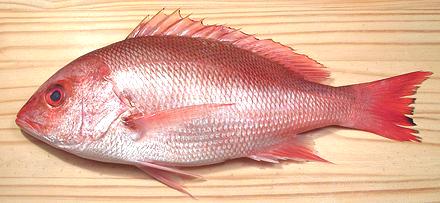 [Lutjanus peru | similar L. campechanus
(Northern Red Snapper (Gulf of Mexico)) | L. purpureus (Southern
Red Snapper (Caribbean))]
[Lutjanus peru | similar L. campechanus
(Northern Red Snapper (Gulf of Mexico)) | L. purpureus (Southern
Red Snapper (Caribbean))]
This true Red Snapper is found from Mexico to Peru in the Eastern Pacific. It can get up to 37 inches long and up to almost 13 pounds but the photo specimen was 15-1/4 inches and weighed 1 pound 14 ounces, a bit larger than average market size. This snapper is a premium fish and fetches a premium price. Pacific Red Snapper is IUCN rated NE (Not Evaluated) but is not considered threatened.
We presume the information below is also correct for the very closely related Northern and Southern Red Snappers from the East Coast. Those are not found in fish markets here in Southern California.
More on Snapper Family
Pacific snapper is an exceptionally well behaved and tasty fish for all methods of cooking and this has made it rather expensive. Most of the fish I buy cost between US $1.99 and $3.99 per pound at the local Philippine fish market, but the snapper in the photo was 2013 US $6.99 per pound. Is it worth the premium price? It pains my frugal** soul to say it, but yes, it can be, particularly for making soup - but, if it's just too painful, see Cardinal Snapper and Lane Snapper.
The flesh is near white with a couple darker streaks just under the skin. It is flavorful enough for fish lovers but not so strong as to deeply offend those who prefer their fish white and flavorless. This fish is featured in our article on Baking Fish
Cooking: This is a fine fish for just about any method of cooking: pan fried, steamed whole, baked, poached or in soup. Skinless fillets hold together well enough that whole fillets from fish weighing up to 1-1/2 pounds can be poached and served without breaking up. Fillets can be pan fried skin-on. Fry the non-skin side first to stiffen the fillet, then flip over and pat the fillet down flat with the turner. Once flattened it will stay flat.
This is not the fish used for Blackened Redfish. That's the Red Drum, which is often not actually red.
Scales: The scales are of medium size and strong, but scrape off rather easily with only moderate flying about. Unlike most fish, a fair amount of the red color is in the scales so it'll be a lighter red when they are scraped off.
Cleaning: This fish presents no particular problems in cleaning. Unless the fish is very large you can pull out the gills with just your fingers.
Fillet: This is a very easy fish to fillet with easy to follow bone structure. There should be almost no flesh left behind. I usually remove the head before filleting. Tilt the knife to get under the gill covers to get as much flesh as possible. There will be a couple small bones you'll need to cut with kitchen shears, and then the backbone. When filleting, minimize bending the flesh as it tends to flake apart.
The rib cage looks easy to follow, but when I get to it I just cut the ribs away from the backbone with kitchen shears and pull them from the fillet with long nose pliers. They pull easily and cleanly. There is a row of substantial centerline spines which need to be pulled, extending from the front cut to the end of the body cavity.
Skin: The skin has no strong or "off" flavor and shrink is quite moderate so steaming and baking whole fish works well, even without slashes through the skin for moderate sized fish. Fillets can be pan fried skin-on. The skin is thin, but fairly strong, so fillets can be skinned easily using the long knife and cutting board Method. You will loose a small lump of flesh from the skirt, which can be used for some other purpose. The skins can be included with heads, bones and fins for making stock.
Yield: A 1 pound 14 ounce fish yielded 15-5/8 ounces of skin-on fillet (52%), and 14-1/4 ounces skinless (48%). A smaller 1 pound 1 ounce fish yielded 8-1/2 ounces skin-on (50%) and 7-1/2 ounces skin-off (44%). This is a fairly good yield.
Stock: The head, bones and fins make a very fine nearly clear soup stock - and you can even toss in the skins for better yield. There is little oil, but what there is should be removed - use your gravy separator. This stock is so good that to make a fine fish soup a shake of salt is all the ingredients you need. For details see our Fish Stock page.
** Frugal: This is a polite word to use when what you really mean is "cheap, totally cheap, I mean really painfully cheap". It has replaced "a bit Scotch", which is both grammatically and politically incorrect.
sf_snapprz 080607 - www.clovegarden.com